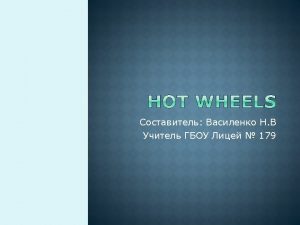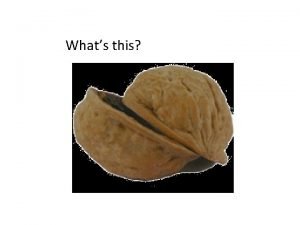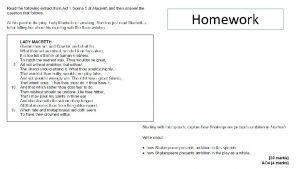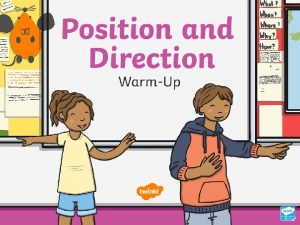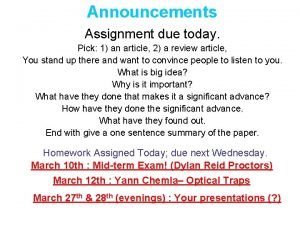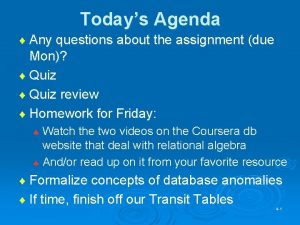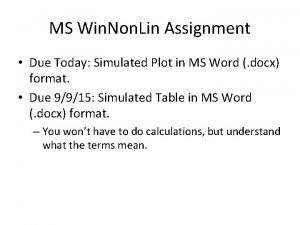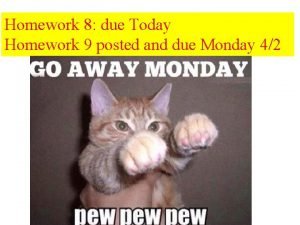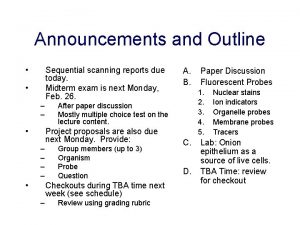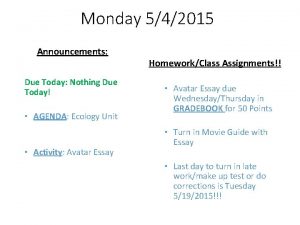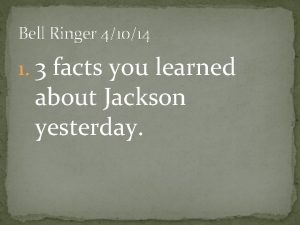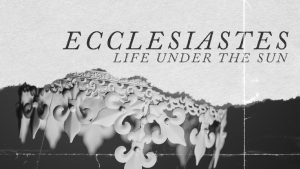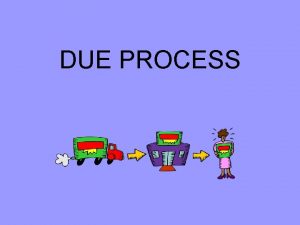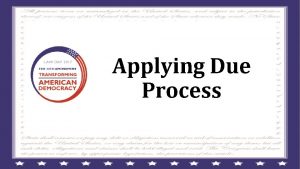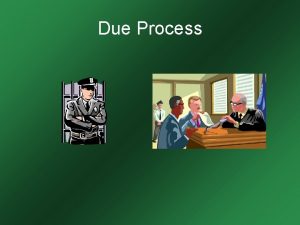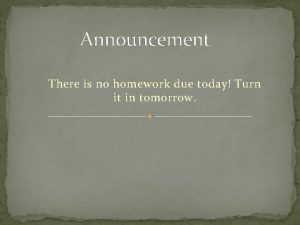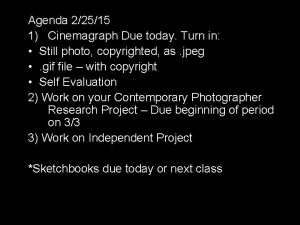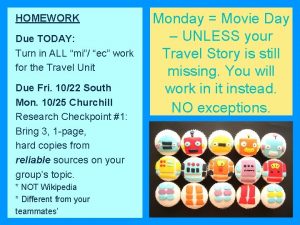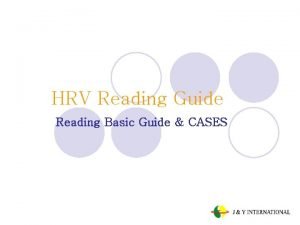Due today Reading Guide 41014 1 Turn to























- Slides: 23

Due today: Reading Guide 4/10/14 1. Turn to your Volcano Video Facts page from yesterday. 2. We will take our quiz after I check your video notes. Study Guides on the front table. Important Dates 4/10 Reading Guide Due Earthquake Quiz 4/11 Library Day Study Guide given out in class 4/15 Test Unit 5: Volcanoes and Earthquakes ACT 4/16 Unit 6 Vocabulary Due Honors Unit 6 Current Event Due

Volcano Articles (20 minutes) • Title • “Dictionary” – Find the “dictionary” section at the end of the article. Write all words and definitions on your sheet. • Main Idea (in your own words) – 2 details – Each detail should include one piece of evidence/fact/statistic/quote

Volcanoes-place where magma reaches the surface of Earth

CRUST: the solid top layer of the earth, including the continents and the land under the oceans MANTLE: the liquid layer of the earth below the crust MAGMA: hot molten (liquid) rock below the earth’s surface LAVA: hot molten rock that flows from a volcano PLATES: large chunks of the earth’s crust that “float” on top of the mantle VENT: the opening through which volcanic material comes out CRATER: a large hole formed by the explosion or collapse of a volcanic vent LAVA LAKE: a pool of molten lava contained in a vent or crater HOTSPOT: area in the earth’s crust where magma rises and pushes through the surface



Magma • Forms wherever temperature & pressure are high enough to melt rock, i. e. the asthenosphere, plate boundaries • Less dense than solid rock near it, so moves upward through fractures • When magma reaches the surface it is called lava.

What determines the type of eruption? • Gases in Magma – Water vapor, carbon dioxide, hydrogen, sulfur – Amount of gas determines type of eruption – Large amount of gas = explosive eruption • Silica Content – Mafic: low silica, lava runs smooth, quickly – Felsic: high silica, lava runs more slowly, explosive, viscous (thick)




SHIELD VOLCANOES • Mafic lava =Low silica level • Low viscosity lava (thin) • High or low levels of gas • Flattened mound that resembles a warrior’s shield

MAUNA LOA, HAWAII Surtsey, Finland Piton de la Fournaise

COMPOSITE VOLCANOES Felsic lava = High in silica High viscosity lava (thick) High levels of gas/Highly explosive Cone shaped formed by layers of lava and volcanic fragments (ash, tephra)

Mt. Fuji, Japan MT. RAINIER, WASHINGTO N Mt. St. Helens, Washington

CINDERCONES Low silica lava High levels of gas Small - less than 300 m high “Fire-fountain” eruptions Made from a pile of rock pieces called tephra

Floreana Island, Galapagos Puu OO, Hawaii PU'U KA PELE, HAWAII

Chapter 18 (10 minutes) Draw the general shape of each volcano on your notes. Answer questions #1 -5 on page 493 (standardized test practice)

Due today: None Do not unpack. Take a copy of the Virtual Volcano Activity. Everyone needs to take one even if you are going to the Pep Rally! Read through the activity. 4/11/14 Important Dates 4/10 Reading Guide Due Earthquake Quiz 4/11 Library Day Study Guide given out in class 4/15 Test Unit 5: Volcanoes and Earthquakes ACT 4/16 Unit 6 Vocabulary Due Honors Unit 6 Current Event Due

Due today: None Make sure the volcano activity from Friday is in your notebook / standard 2. 1 Leave your notebook open to the activity. On the dry erase board: 1. Draw the general shape of each volcano type. Label each. 2. Answer questions #1 -5 on page 493 (standardized test practice) (10 minutes for a stamp) 4/14/14 Important Dates 4/10 Reading Guide Due Earthquake Quiz 4/11 Library Day Study Guide given out in class 4/15 Test Unit 5: Volcanoes and Earthquakes ACT 4/16 Unit 6 Vocabulary Due @ end of class Honors Unit 6 Current Event Due

Due today: Vocabulary 4/17/14 Important Dates Look over your test. The grade is circled. Read through the ones you missed. (5 minutes) HW: Water Cycle 4/10 Reading Guide Due Earthquake Quiz 4/11 Library Day Study Guide given out in class 4/15 ACT Test postponed: work on fault models and volcano chart to USE ON TEST. 4/16 Test Unit 5: Volcanoes and Earthquakes Unit 6 Vocabulary Due @ end of class Honors Unit 6 Current Event Due

4/17/14 • Test Remediation – Required if you scored below a 70 on the test. – Required if you want to take the recovery test on Tuesday @ HH. • Water Cycle Coloring and Questions – Finish today OR it is due for homework. • 30 minutes

• Unit 6 Atmosphere Test: 5/1/14 Page Activity Standard 1 Water Cycle ------- Grade
 Pre reading while reading and post reading activities
Pre reading while reading and post reading activities Write a short article about kimi raikkonen
Write a short article about kimi raikkonen I throw my warlike shield
I throw my warlike shield Answer. go straight turn left turn right
Answer. go straight turn left turn right Turn the arrow 1/4 turn clockwise
Turn the arrow 1/4 turn clockwise 'valiant cousin, worthy gentleman'
'valiant cousin, worthy gentleman' Macbeth seeing banquo's ghost quote
Macbeth seeing banquo's ghost quote Go of the building and turn left
Go of the building and turn left Turn hell hound turn
Turn hell hound turn Tomato flames flaps
Tomato flames flaps Quarter turn half turn
Quarter turn half turn Walk straight and turn (1 نقطة) left right around
Walk straight and turn (1 نقطة) left right around For today's meeting
For today's meeting In todays class
In todays class Meeting objective
Meeting objective Today lesson or today's lesson
Today lesson or today's lesson Today's lesson or today lesson
Today's lesson or today lesson Today's lesson or today lesson
Today's lesson or today lesson Assignment due today
Assignment due today Assignment due today
Assignment due today Assignment due today
Assignment due today Folk culture and popular culture venn diagram
Folk culture and popular culture venn diagram Homework due today
Homework due today Reports due today!
Reports due today!

